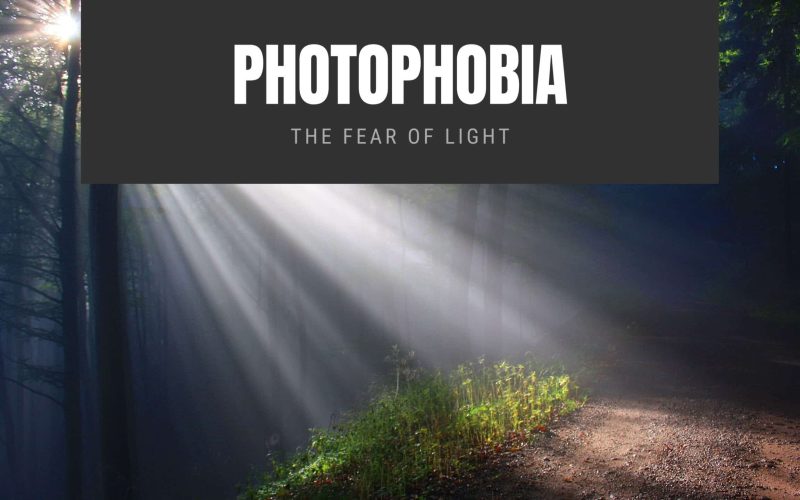Have you ever wondered why your eyes hurt when exposed to intense light? You could have photophobia (light sensitivity). But what does that mean?
Photophobia is a medical condition that reduces the eye’s ability to tolerate light. It could be a symptom of a medical problem or lead to other problems when not managed.
This post explains more about photophobia.
What Does Photophobia Mean?
Photophobia means the fear of light and describes an intolerance or painful sensitivity to strong light. Photophobia is not a condition or disease; instead, it’s a symptom of another problem.
It is a medical symptom of abnormal intolerance to the visual perception of light and can sometimes lead to squinting eye pain and discomfort.
It occurs as a symptom of diverse conditions such as migraine, cataracts, and eye injuries. This word originated from the Greek words “Phos,” meaning light, and “Phobos,” meaning fear.
Symptoms of Photophobia
Photophobia can occur at any age; the young and old are all prone to it. Different symptoms showcase the condition of photophobia in a person.
These symptoms are:
- Sensitivity to light: A person sensitive to light feels that the light level in the environment is too bright and causes discomfort. This discomfort can be extreme for some people and further reduce their vision.
- Aversion to light: An individual trying to avert the rays of light sensitivity could result from photophobia.
- Difficulty looking at pictures or text: Bright lighting could cause problems or pain for a person with photophobia.
- Tears from the eyes: Another symptom of photophobia is tears streaming down an individual’s eyes due to light sensitivity.
- Pain or discomfort when looking at light: This is another symptom of photophobia, pain, irritation, and discomfort when focusing sight on a light. Sometimes, the pain can be a bit unbearable and might even result in a severe headache.
- Squinting one or both eyes: Sudden lighting, such as car headlights, a brightly turned-on lamp, or even the light switch, can cause people with photophobia to squint either one or both eyes affected by the sudden ray of light.
- Feeling excessive dryness in your eye: A feeling of eye dryness could be a symptom of photophobia or a dry eye disease. Dry eye disease is common when your tears cannot provide adequate lubrication for your eyes. Tears can be inadequate and unstable for many reasons. However, dry eyes may happen if you don’t produce enough tears or if you produce poor-quality tears. This tear instability leads to inflammation and can damage the eye surface.
- Feeling like you want to close your eyes: Sometimes, an individual feels like closing their eyes. However, the constant feeling of shutting his eyes from light rays could result from photophobia.
- A sense that regular or moderate lighting rays appear excessively bright results from photophobia.
Other symptoms like fatigue, nausea, and head pain also indicate photophobia due to irritation or intolerance to bright light and sunlight rays.
Having seen some of the numerous signs and symptoms of photophobia, here are some of the causes.
Causes of Photophobia
Several situations and medical illnesses can trigger the advent of photophobia. Some of these are:
Hypersensitivity to Pain
Migraines (pains) are the most common cause of photophobia. For some people, photophobia occurs at the early stage of a migraine before it becomes very serious.
However, photophobia can also occur alongside the most intense phases of migraine or can last for a day or two after a migraine ends.
Fatigue, trigeminal neuralgia, fibromyalgia, and head trauma can be associated with increased sensitivity to light, manifesting as photophobia.
Head or Face Pain
Dental problems, tension headaches, meningitis, or optic nerve disease (such as optic neuritis due to multiple sclerosis) can all irritate your eyes, causing photophobia. Sometimes, photophobia may be the first symptom of one of these illnesses.
Eye Problems
Photophobia can be quite severe when caused by diseases of the eyes. In these situations, your eyes might not adequately protect you from light and can make you sense moderate light as extremely bright.
Photophobia is the root of many eye problems. In addition to the sensation, patients may experience severe pain, vision changes, and eye redness.
Common eye conditions that cause photophobia include:
When to See a Doctor?
Some people often wait until their medical condition worsens before seeking medical help. This is wrong as it can escalate a minor situation into a very problematic one.
Seek medical help when sensitivity or intolerance of light becomes severe, painful, reddens, or swells the eye alongside irritation or in cases where sunglasses are needed indoors.
Also, when the headache and the other symptoms listed do not wear off in a day or two, it is advisable to see the doctor.
The eye is a very delicate part of the body. Therefore, it must be cared for appropriately to prevent minor symptoms or conditions from escalating into partial loss of vision.
How is Photophobia Diagnosed?
Another question that ponders the heart of many tends to be, “How can photophobia, which is not a disease but rather a condition or symptom of another medical illness, be diagnosed?”
Once the symptoms of photophobia persist, consulting medical help is the next step. The doctor will find the cause of the patient’s photophobia by listening to their medical history, performing a physical examination, and an eye examination through specialized diagnostic tests to confirm the exact problem of the patient and administer treatment appropriately.
How to Treat Photophobia?
There are two stages of photophobia treatment, starting from the pre-treatment.
Pre-treatment
There are diverse pre-treatments in eradicating the symptoms of photophobia, which are:
- Specifying the aggravating or triggering sources: This creates awareness of bright light, such as fluorescent lighting, that can trigger pain sensitivity.
- A complete workup and diagnosis: placing an appointment with a comprehensive doctor will help the root cause of the sensitivity.
- Seek the assistance of a specialist for the condition to help relieve the pain and procure lasting soothing treatment.
Treatments for Photophobia
Various options exist to relieve or remedy treating photophobia (light sensitivity). This method helps ease the painful sensitivity of light.
- Precision-tinted glass: The most effective tool for combating photophobia is precision-tinted glasses. Research shows these lenses help regulate and relieve the most chronic light-sensitive individuals. They help reduce generalized light sensitivity, particularly from fluorescents.
- Botox injections: studies have proven that these injections are effective for people with migraine-related photophobia.
- Acetaminophen: This is another temporary option for acute photophobia. This pain-relieving drug alleviates most burdensome migraine symptoms, especially light sensitivity, during the first two hours of administration.
To be free from photophobia, consider these treatment methods and adequately comply with the doctor’s instructions. You can be sure of soothing relief from the painful light sensitivity.
Conclusion
Photophobia can be curtailed and treated ideally by following accurately the treatment measures diagnosed by a specialized professional. Though every individual cannot avoid light, it is advisable for patients who sense the symptoms of severe sensitivity to light to act quickly. This will ensure that the body’s most delicate and alluring part, the eye, is not affected but rather in perfect and hale condition.








